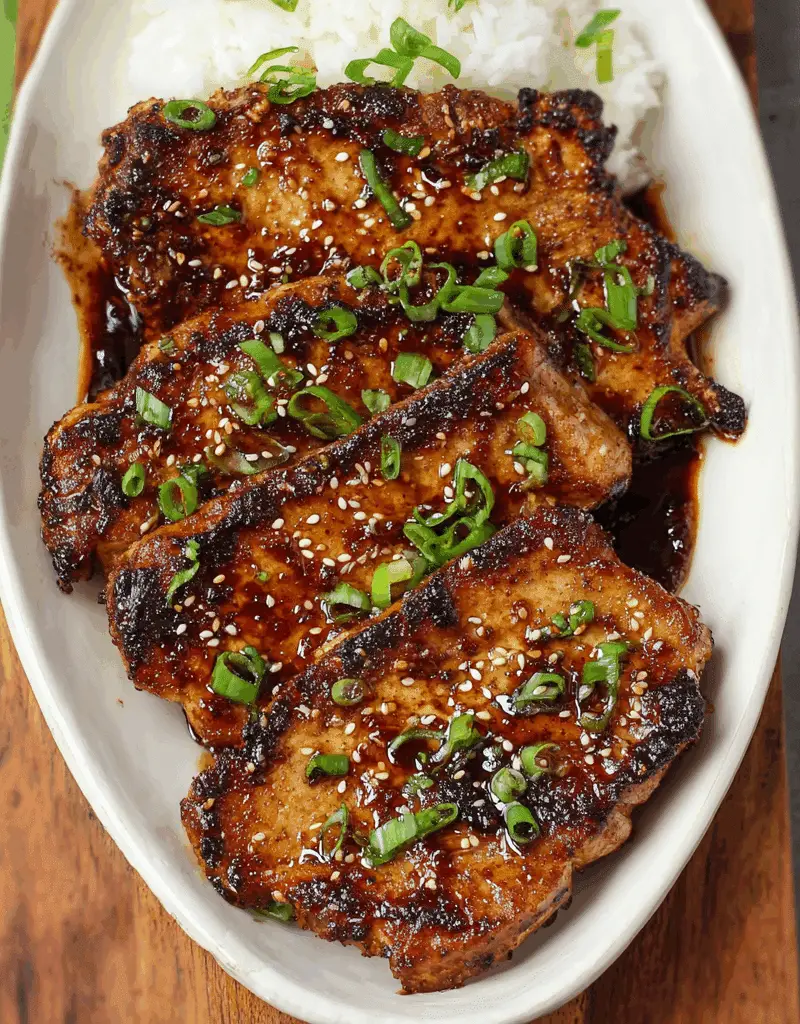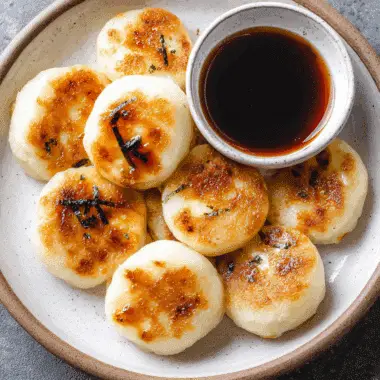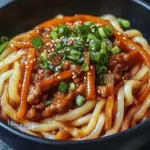The savory sweetness of soy, brown sugar, and sesame oil combines with the fiery kick of gochujang in these mouthwatering Korean Glazed Pork Chops. With every juicy bite, you’ll get a beautiful balance of spice, umami, and just the right touch of tang — making it a truly unforgettable dish.
Whether you’re feeding your family on a busy weeknight or looking to impress with something new, this Korean-inspired pork chop recipe is both simple and sensational. The sticky glaze and tender oven-baked chops come together in under 40 minutes, proving you don’t need hours to create something extraordinary. Pair it with steamed rice and sautéed veggies for a complete, flavor-packed meal.
Full Recipe
Ingredients:
-
4 bone-in pork chops (about 1-inch thick)
-
1/4 cup low sodium soy sauce
-
1/4 cup brown sugar
-
2 tablespoons sesame oil
-
2 tablespoons rice vinegar
-
1 tablespoon gochujang (Korean chili paste)
-
4 cloves garlic, minced
-
1 tablespoon fresh ginger, grated
-
1 teaspoon black pepper
-
1 tablespoon cornstarch
-
1 tablespoon water
-
1 tablespoon sesame seeds (for garnish)
-
2 green onions, sliced (for garnish)
Directions:
-
In a small bowl, whisk together soy sauce, brown sugar, sesame oil, rice vinegar, gochujang, garlic, ginger, and black pepper to make the marinade.
-
Place pork chops in a large zip-top bag or shallow dish and pour the marinade over them. Cover and refrigerate for at least 30 minutes (or up to 4 hours).
-
Preheat oven to 400°F (200°C).
-
Remove pork chops from marinade and reserve the excess liquid. Place chops on a baking sheet lined with foil or parchment paper.
-
Bake for 20-25 minutes, turning halfway through, until internal temperature reaches 145°F (63°C).
-
While pork chops are baking, pour reserved marinade into a small saucepan. Bring to a boil, then reduce heat.
-
In a separate bowl, mix cornstarch with water and add to saucepan, stirring until thickened into a glaze (about 2–3 minutes).
-
Remove pork chops from oven and brush generously with glaze.
-
Sprinkle with sesame seeds and sliced green onions before serving.
Prep Time: 10 minutes | Cooking Time: 25 minutes | Total Time: 35 minutes
Kcal: 390 kcal | Servings: 4 servings
Introduction to Korean Glazed Pork Chops
Korean cuisine is known for its bold flavors, intricate marinades, and masterful use of spice, sweetness, and umami. Korean Glazed Pork Chops embody all these attributes in one delicious dish. This recipe has quickly become a staple in many home kitchens, not only because it’s easy to prepare, but also because it brings restaurant-quality flavor to the dinner table without requiring specialty equipment or hard-to-find ingredients. The secret lies in the glaze—a rich, sticky mixture built on the foundations of soy sauce, brown sugar, sesame oil, rice vinegar, garlic, and the essential Korean chili paste: gochujang. This iconic condiment adds heat and depth to the dish, giving it that unmistakable Korean flavor profile.
Unlike traditional grilled or pan-fried pork chops, this version is baked in the oven, allowing the glaze to thicken and coat each chop beautifully. When the chops emerge, they’re glistening with a caramelized crust that’s packed with flavor and irresistible to look at. This dish is perfect for weeknight meals, casual dinner parties, or a weekend treat when you’re craving something savory and satisfying with a hint of spice.
What Makes These Pork Chops Uniquely Korean
The standout element of these pork chops is the gochujang glaze. Gochujang is a fermented chili paste made from red chili powder, glutinous rice, fermented soybeans, and salt. It’s both spicy and slightly sweet, giving dishes a deep umami flavor that can’t be replicated with other condiments. In Korean cooking, gochujang is used in everything from stews and soups to marinades and sauces.
Pairing this chili paste with soy sauce and brown sugar creates a perfect sweet-and-salty base, while fresh garlic and ginger add aromatic layers that round out the glaze. The inclusion of rice vinegar brings a subtle acidity that balances the richness of the pork and glaze, keeping each bite vibrant and not overly heavy. The glaze not only serves as a marinade but also as a finishing sauce, creating that beautiful, glossy texture that defines the dish.
The Versatility of This Dish
Korean Glazed Pork Chops are incredibly adaptable, making them an excellent recipe to keep in your regular rotation. While bone-in pork chops provide the best flavor and moisture retention, you can easily use boneless chops or even pork loin. If you’re cooking for a crowd, the recipe can be doubled or tripled without much added effort.
This dish also pairs well with a variety of sides. Traditional Korean accompaniments like steamed rice, kimchi, pickled radish, or sautéed spinach complement the rich flavors of the glaze. For a more Western take, mashed potatoes, roasted vegetables, or even a simple green salad work beautifully. You can also slice the cooked pork and serve it in lettuce wraps with a drizzle of leftover glaze for a lighter, low-carb version.
Why This Recipe Works for Busy Home Cooks
One of the most appealing aspects of this recipe is its simplicity. With just 10 minutes of prep time and around 25 minutes in the oven, you can have a full, flavorful dinner on the table in under 40 minutes. There’s no need for complicated steps or long marinating times—though marinating the pork for a couple of hours certainly intensifies the flavor, it’s not mandatory for a delicious result.
The glaze itself comes together in minutes and can even be made ahead of time and stored in the refrigerator for up to a week. This makes it an ideal option for meal prepping or for those evenings when time is limited but you still want something hearty and homemade.
Nutritional Considerations
Despite its decadent flavor, Korean Glazed Pork Chops are relatively balanced in terms of nutrition. Pork is a high-protein meat that provides essential vitamins like B6 and B12, along with minerals like zinc and selenium. Using lean cuts such as center-cut chops can reduce the fat content, while baking instead of frying keeps calories in check.
The sauce does contain sugar, so those watching their sugar intake might consider reducing the brown sugar slightly or using a sugar substitute like coconut sugar or monk fruit sweetener. Additionally, opting for low-sodium soy sauce helps control the overall salt content. With a few small tweaks, this dish can fit well into a variety of dietary plans, from high-protein to moderate-carb.
Cultural Relevance and Flavor Tradition
In Korean cuisine, meat dishes are often celebrated for their marinades and glazes, which transform simple cuts into deeply flavorful meals. Bulgogi (marinated beef), galbi (short ribs), and spicy grilled chicken all utilize similar components found in this glaze: soy, sugar, garlic, and gochujang. These elements have deep roots in Korean food culture, where balance and fermentation are key.
The sweet heat of gochujang mirrors the complexity often found in traditional Korean dishes. It also aligns with the Korean principle of “bibim”—meaning to mix—which is reflected in the layered flavor of the sauce. Serving these pork chops with banchan (a spread of small side dishes) can further elevate the experience, offering a touch of authenticity even in a modern or Western kitchen.
Perfect for Entertaining
Whether you’re hosting friends or just want to create a meal that feels special, Korean Glazed Pork Chops are guaranteed to impress. The dish’s presentation is naturally elegant—glazed meat garnished with sesame seeds and scallions is visually striking. Its bold, sticky-sweet coating makes it ideal for plated dinners or even casual buffets.
To build a Korean-inspired menu around this dish, consider starting with a light cucumber salad, followed by the pork chops as the main entrée, served with kimchi fried rice or japchae (glass noodles). Finish with a refreshing dessert like ginger-honey poached pears or a scoop of green tea ice cream. The flavor journey will leave your guests completely satisfied.
Storage and Reheating Tips
Leftovers of Korean Glazed Pork Chops reheat beautifully. Store any remaining pork in an airtight container in the fridge for up to 3–4 days. When reheating, a quick stint in the oven or a covered skillet with a splash of water can bring back the moisture and warmth. Microwaving is also an option, though you may lose some of the crisp texture of the glaze.
The leftover glaze itself can be repurposed for stir-fries, drizzled over rice bowls, or used as a dipping sauce. It’s a versatile component worth saving and experimenting with in other meals.
Make It Your Own
There’s plenty of room to personalize this recipe. Add a touch of citrus (like lime zest or juice) for brightness, or stir in some chopped chili peppers for extra heat. You can even try swapping out pork for chicken thighs or tofu for a vegetarian twist. The key is maintaining that balance of savory, sweet, spicy, and umami in the glaze.
If you’re looking for a gluten-free version, use tamari or coconut aminos in place of soy sauce and ensure that your gochujang is gluten-free (many are, but some are not—check the label). This flexibility makes the dish suitable for a wide range of dietary needs without compromising flavor.
Conclusion
Korean Glazed Pork Chops are the perfect representation of what makes Korean-inspired cooking so exciting—bold flavors, satisfying textures, and an irresistible glaze that turns a simple cut of meat into something extraordinary. This dish is more than just a quick dinner option; it’s a flavor-packed experience that introduces your taste buds to the vibrant world of Korean cuisine.
Whether you’re cooking for your family on a busy weekday or entertaining guests over the weekend, this recipe delivers on all fronts: ease, taste, nutrition, and visual appeal. It’s a reliable go-to that belongs in every home cook’s arsenal. Don’t be surprised if it becomes one of your most requested dishes—it’s just that good.








